Transitioning From Classroom to Online Instruction: Behind the Scenes as Dickinson College Brings the Liberal Arts Online
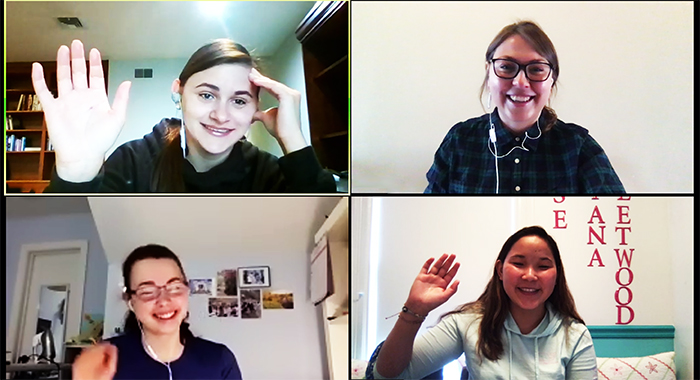
Using applications like Zoom, Dickinson professors hold synchronous classes, breakout discussions and office hours. Students remain connected with professors and classmates while studying from home during the COVID-19 coronavirus pandemic.
As COVID-19 pandemic closes campus, faculty, administrators, students pivot to online
by MaryAlice Bitts-Jackson
As reported cases of the novel coronavirus COVID-19 ramped up in America, Dickinson professors answered the call to transition to online instruction. That's a tall order in this close-knit liberal-arts community, where no distance-learning program exists and where workshop-style and active-learning classes, student-faculty research projects and small-group discussions are hallmarks of the educational experience. Add to this an international student population returning home to multiple time zones and the already hectic rhythms of mid-spring-semester, and you have an even bigger challenge.
And it all came together in a week.
So how did this small, residential college pivot so quickly, midsemester, to provide students with uninterrupted access to their education? What special challenges arose? And how are they preserving and growing a crucial sense of community during an unsettling time?
Training, advising and access
In March, Dickinson President Margee Ensign extended spring break by a week to provide time for the transition. Professors’ skill varied widely: Some arrived with prior experience through digital humanities projects and programs like Dickinson’s Willoughby Institute for Teaching With Technology and had clear ideas of how to proceed. Others had never used any online-instruction technologies and needed help imagining the possibilities and learning the ropes. Most were somewhere in between.
Dickinson’s Library & Information Services (LIS) division was up to the challenge.
The academic technology department had four days to develop software recommendations and create tailored training sessions and four days to deliver face-to-face training to professors. They created a dedicated website on the academic-technology site Moodle and posted all of the workshop videos, along with additional resources for remote teaching. Staff members remained available to advise professors one-on-one.
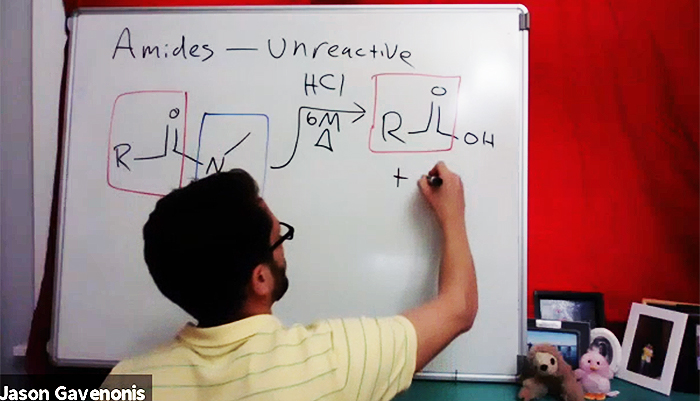
Assistant Professor of Chemistry Jason Gavenonis simulates a classroom experience from his home office.
To make the recommended applications available, LIS secured videoconference and screen-recording application licensing to allow faculty access to advanced features and loaned tools like iPads, cameras and microphones to professors who didn’t own them. For students requiring specialized software that was only licensed for on-campus use, like programs used in data-analysis classes, LIS combined two new technologies to quickly provide access. (Additional software licensing was also available through individual vendors’ COVID-19 response outreach efforts.) LIS also made repurposed campus computer-lab equipment available to those who needed it.
Meanwhile, the library staff helped faculty transition from print-based resources to digital ones and provided content for the teaching resource site. LIS support is ongoing, as the library fields questions from students and faculty via the virtual "Ask a Librarian" service.
Tapping the wider community
Professional networks and the greater Dickinson community provide additional resources for educators like Professor of Political Science Jim Hoefler, who got his classes up and running by recording a videoconference call with Brian Kamoie '93, an expert in federal disaster preparation and response, and using it to create videos for his senior seminar as well as his policy and health classes to discuss online. He’s also augmenting his health-studies lessons with prerecorded videoconference sessions with experts at Penn State Hershey School of Medicine.
In the midst of the transition, Professor of International Business & Management Steve Erfle added another class to his schedule to accommodate Dickinson students who'd been studying abroad when the pandemic hit. While in Bologna, Italy, the students were enrolled in a class on food, wine and tourism that fulfills international business & management credits. Erfle brought the class online, focused it on the alcoholic-beverage industry and tapped his wide and deep wine-industry contacts to bring guest-speakers to his virtual classes. These include two former teaching assistants, the class of '06's Andy Keller and Rick Gunnell, who managed a wine bar in Napa Valley soon after graduation, as well as industry luminary Evan Goldstein and Paul Bush, son of Dick Bush and owner of Madroña Vineyards.
Teaching across time zones
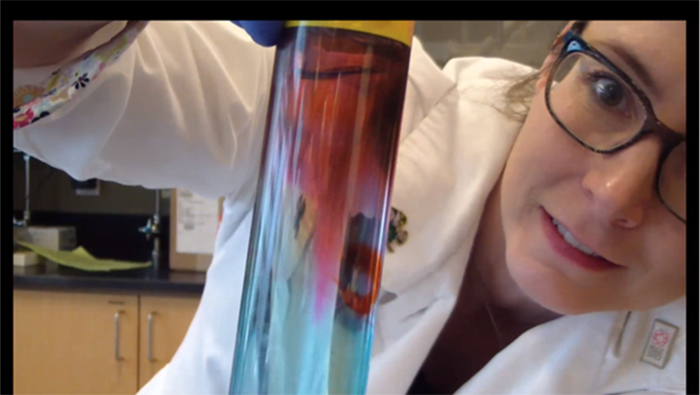
Associate Professor of Chemistry Sarah St. Angelo records an experiment in progress.
Learning and accessing remote-instruction tools was just the beginning. Professors had to factor multiple time zones into their plans—a major consideration at Dickinson, which draws students from 49 countries.
Professor of Mathematics Dick Forrester has many international students in his classes, so he knew real-time videoconferencing wouldn’t work. By creating narrated PowerPoint presentations, recorded as videos and uploaded to Microsoft Stream, he makes lectures available on demand. He also holds virtual meetings during the regular class times and records them for all students who can’t attend.
Science and language labs
Professors teaching lab- and workshop-based classes faced unique hurdles. The chemistry department is simulating experimentation by using GoPro cameras in the lab and sharing videos. After students watch the procedures online, they collect data and analyze it, completing the lab. “I feel that they are getting as real of an experience as can be expected under the circumstances,” says Amy Witter, professor of chemistry. “It’s almost as though they are present in the lab.”
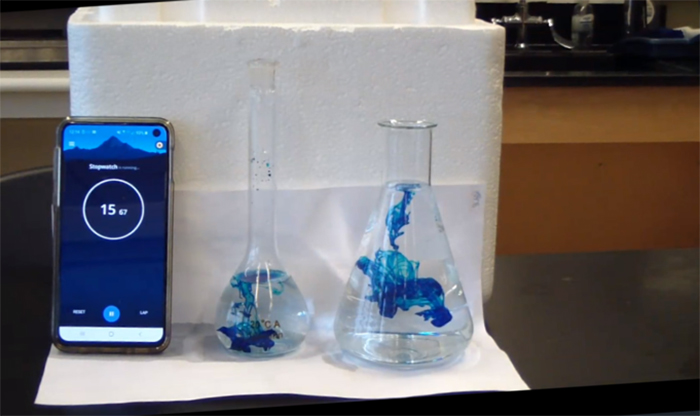
Students view an experiment virtually, then use the data to complete the lab.
Beginner language labs are best done synchronously, says Assistant Professor of Russian Alyssa DeBlasio, because real-time interaction is paramount to building conversational skill. Her Russian-department colleagues assessed each course individually to determine the digital methods that best fit students’ needs. While some classes meet via videoconference at their previously scheduled times, others split into smaller conversation groups. Students preparing to study in Russia next year also meet synchronously online—not only to maintain conversational proficiency but also to retain the friendships and network they’ll rely on while studying abroad.
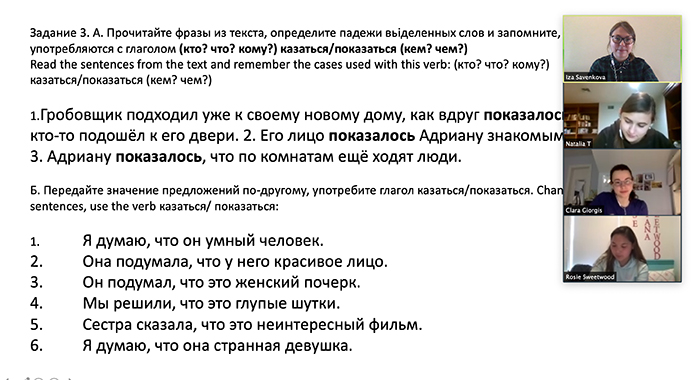
Students in Iza Savenkova's Russian class can see each other while also accessing assignments.
Arts and social distancing
Interpersonal exchange is also vital for student-performers. While Director of Dance Sarah Skaggs originally planned to solicit videos of students dancing on their own, her students requested twice-weekly synchronous videoconference meetings. At the time of this writing, they’d just completed a virtual warmup session. “We had a blast. It’s was like being on the Brady Bunch or Hollywood Squares,” says Skaggs, referring to the video blocks that appeared on the screen, showing all of the dancers as they planked and pliéd together. “After the class, they said they felt much better. Dancers need to see each other as they chat, train and perform.”
Another challenge for arts departments: Tailoring crucial exhibitions and performances for the social-distancing era.
The Freshworks concert and art & art history exhibitions are culminating projects for students studying choreography and visual art. When the COVID-19 state of emergency was declared in America, the art-history senior exhibition had already opened, but the public presentations for dance and studio art were still in the works. The arts departments are on the case: Plans are underway to present a virtual senior studio-art exhibition and a virtual livestreamed dance concert in the spring. Other livestream events that are part of the arts curriculum include a virtual cold-read of a play—an essential aspect of a student's senior theatre project. Outside of class, the Mermaid Players theatre group will present a virtual cabaret.
Nurturing community
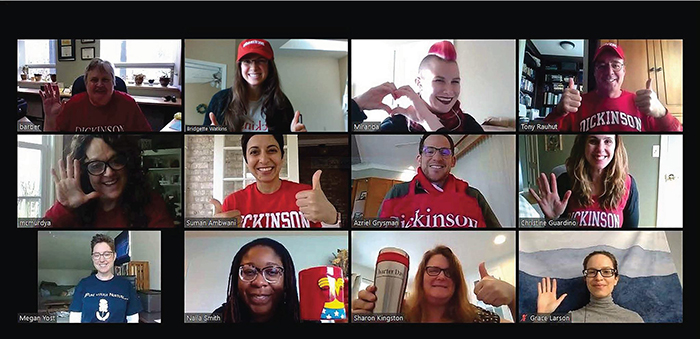
The psychology department's recent virtual meeting brimmed with Dickinson spirit.
Underpinning all of these efforts is the college’s unwavering commitment to personalized instruction and community building. In a stressful time, as Dickinson’s Division of Student Life works with student leaders to provide digital spaces for students to gather and connect and college administrators reach out to the campus and local communities through livestream meetings, professors and administrators continue to nurture social ties.
Professor of Music Ellen Gray and Assistant Professor of Political Science David O’Connell, for instance, use social media, real-time online meetings and virtual office hours to remain connected. Last week, Gray sent a warm, affirming message about community-building in her music-history classes, while O’Connell’s playful Instagram shout-out to his students helped bring some much-appreciated levity to spring break.
Assistant Professor of Theatre & Dance Karie Miller, who uses videoconferencing to deliver synchronous acting and directing classes, organized a live karaoke assignment for her acting class to break the ice and make students more comfortable in virtual spaces. It worked, Miller emphasizes, because of the deep ties that already exist. “I spent a lot of time at the beginning the semester building classroom community and normalizing vulnerability,” she says.
Stephanie Uroda ’23 (chemistry, neuroscience), appreciates her professors' efforts to foster a continued sense of belonging and support.
"These are scary, confusing and stressful times," says Uroda, who makes a point of checking in with classmates virtually. “The professors have been great about keeping themselves available to us to answer any questions and make any necessary accommodations. Although I would much prefer in-person teaching, I think my professors have done an excellent job at making the best of a bad situation and doing all they can to make sure we can succeed.”
Read more stories about how members of the Dickinson community near and far have responded to emerging needs and challenges during the coronavirus pandemic.
TAKE THE NEXT STEPS
Published March 30, 2020